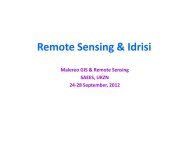Practical Manual - Malareo
Practical Manual - Malareo
Practical Manual - Malareo
You also want an ePaper? Increase the reach of your titles
YUMPU automatically turns print PDFs into web optimized ePapers that Google loves.
Acquiring Spatial Data<br />
There are numerous types of data available and the sources of these data are varied. The quickest and<br />
easiest source of data is the internet and a fair number of the coverages (layers) you are using come<br />
from the internet. However data often has restrictions associated with it, be that in terms of distribution<br />
or utilization. Often free data is made available for education and research but not for profit. Also as the<br />
data is free there is no guarantee of accuracy or content. This needs to be taken into account. A highly<br />
accurate source of data is usually government departments especially the Surveyor General of a<br />
country. Data providers can also be employed to acquire data, be that from aerial photography or<br />
individual GPS surveys or projects. How you source data is dependant on the needs of the project and<br />
the budgets available.<br />
GIS Data can be acquired from various sources or using various means. These include government<br />
departments, Data vendors, the internet, from a GPS, on screen digitizing, importing images and georeferencing<br />
them and importing CAD diagrams and converting formats.<br />
A number of sources of data include:<br />
Diva GIS http://www.diva-gis.org/gdata<br />
GeoSpatial Portal http://www.opengeospatial.org/<br />
Free Maplibray http://www.maplibrary.org/<br />
The Protected Planet (Conservation Areas) http://protectedplanet.net/<br />
The USGS http://glovis.usgs.gov/<br />
Therea re literally dozens of sites available for downloading data, each with their own requirements.<br />
Go to the DIVA GIS site on your browser and Download the Administrative boundaries for South Africa<br />
(if you do not have an internet connection these are available in your data folder.<br />
Most data is in a zipped format (8.zip or *.rar) and will need to be extracted into a usable data type or<br />
format. In most cases this will ultimately be as shape files.<br />
Data Formats<br />
There are numerous data formats that are used by different GIS systems. These include but are not<br />
limited to:<br />
ESRI Shape files (*.shp)<br />
ESRI Personal Geodatabase (*.mdb)<br />
ArcInfo Ascii (*.e00)<br />
MapInfo (*.tab)<br />
Microstation (*.dgn)<br />
Comma Delineated text (*.csv)<br />
QGIS for Malaria Page 17




